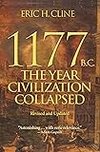
Saved by Margaret Leigh and
1177 B.C.

Saved by Margaret Leigh and
The year was 1177 BC. It was the eighth year of Pharaoh Ramses III’s reign.2 According to the ancient Egyptians, and to more recent archaeological evidence, some of the Sea Peoples came by land, others by sea. There were no uniforms, no polished outfits. Ancient images portray one group with feathered headdresses, while another faction sported
... See moreAccording to Joseph Tainter, who literally wrote the book on the collapse of complex societies, “collapse is fundamentally a sudden, pronounced loss of an established level of sociopolitical complexity.”
Few events had a bigger impact on the evolution of the ancient world than the end of the Bronze Age. It was then that the great kingdoms and city-states of prehistory fell. They left behind stirring monuments like the Pyramids and dimly remembered tales such as the ones that were eventually reshaped into the Trojan War saga.
Earlier scholars occasionally pointed to mentions in the Linear B tablets found at the site which suggest that there were “watchers of the sea” in place during the final year(s) of the site’s occupation, and have hypothesized that they were waiting and watching for the Sea Peoples. However, it is not clear what these tablets are documenting, and,
... See moreAccording to Ramses’s inscriptions, no country was able to oppose this invading mass of humanity. Resistance was futile. The great powers of the day—the Hittites, the Mycenaeans, the Canaanites, the Cypriots, and others—fell one by one. Some of the survivors fled the carnage; others huddled in the ruins of their once-proud cities; still others
... See moreTwo decades later, Christopher Monroe cited Liverani’s work and suggested that the economy of the Late Bronze Age became unstable because of its increasing dependency on bronze and other prestige goods. Specifically, he saw “capitalist enterprise”—in which he included long-distance trade, and which dominated the palatial system present in the Late
... See moreHowever, both Gibbon and Diamond were considering how a single empire or a single civilization came to an end—the Romans, the Maya, the Mongols, and so forth. Here, we are considering a globalized system in antiquity, with multiple civilizations all interacting and at least partially dependent upon each other.
She suggested instead that “mounting internal conflicts and gradual decline, culminating in the final assault on the major political and religious foci of the city’s elite, provides the most plausible alternative framework for the explanation of the destruction and abandonment of Hazor.”
a Hittite diplomatic treaty in which a deliberate economic embargo against the Mycenaeans is spelled out—“no ship of the Ahhiyawa may go to him”—and it seems quite likely that we are looking here at one of the earliest examples in history of such an embargo.